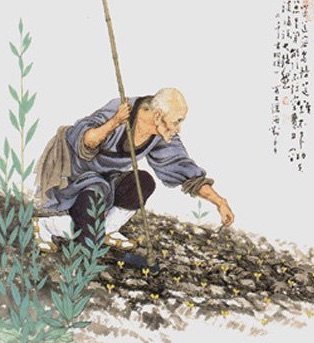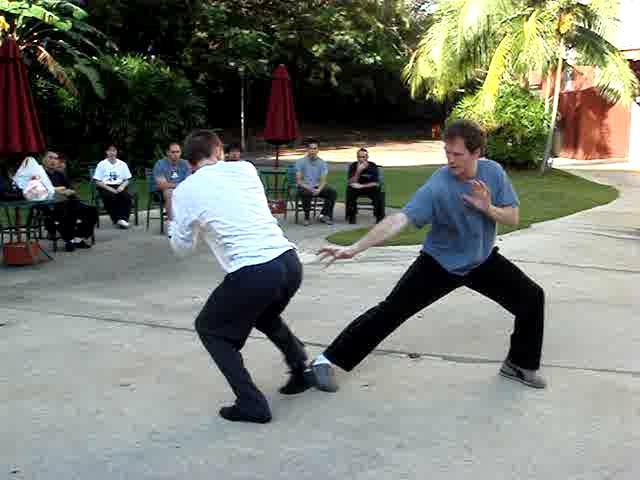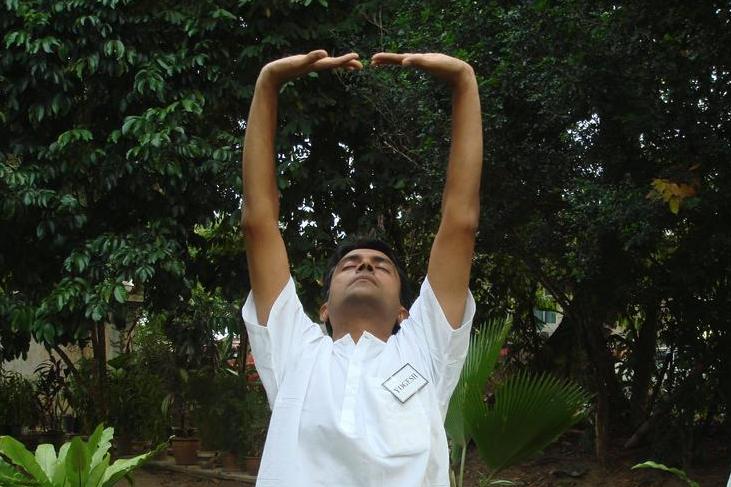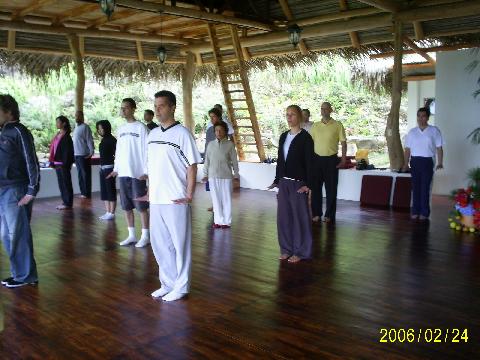SELECTION OF QUESTIONS AND ANSWERS
NOVEMBER 2011 PART 1

The great Zen maser, Bai Zhang. Picture reproduced from http://www.confuciusonline.com/people/15052
Question 1
One other thing I was wondering about was meat eating. Can you please explain what Buddhism says about meat eating and whether it is allowed in Buddhism to eat meat? In the Mahaparinirvana Sutra, for example:
Kasyapa said again: "Why did you first allow the bhiksus to eat three kinds of pure meat?"
"O Kasyapa! These three kinds of pure meat were so instituted following the need of the occasion."
Bodhisattva Kasyapa said again to the Buddha: "O World-Honoured One! In what circumstances do you not allow the ten impurities or the nine kinds of what is pure?"
The Buddha said to Kasyapa: "This also is permitted by gradual steps following the need of the occasion. This is what applies in the actual segregation from eating meat."
— Ahsun, UK
Answer
As far as I know, the Buddha did not forbid his followers to eat meal. But he did forbid his followers to cause animals to be killed so as to provide meat for them to be eaten.
Buddhism is a practical religion. Rules were not made out of intellectualization; they were made to meet expedient needs of the occasion.
During the Buddha's time, devotees provided food for monks. It was a blessing for the devotees to do so. Monks would prefer vegetarian food, but if some unsuspecting devotees provided food with meat in it, the monks would eat it.
In Tibet where Vijaryana Buddhism was practiced, vegetables were (and still are) very scarce. Hence, it was not uncommon for Vijrayana monks to eat meat.
In China, where Mahayana Buddhism was widely practiced, situations were quite different. Monks cultivated their own vegetables. A great Zen master, Bai Zhang, introduced some monastery rules for his students where eating meat was forbidden. These rules were so useful that soon monks from other monasteries and later all Mahayana monks followed these "Monastic Rules of Bai Zhang".
Monastic rules are meant for monks, not lay persons. If lay Buddhists eat meat and have sex with willing partners, that is fine. Indeed, the Buddha encouraged his lay followers to enjoy wholesome sex as it contributed to family happiness.
Neither the Buddha nor Bai Zhang forbade monks to drink Coca Cola or wear gold watches. So if modern Shaolin monks, who are supposed to practice Mahayana Buddhism, drink Coca Cola and wear gold watches, that is fine, though some people may find it disturbing. But if they have sex and also children, and eat meat in public, it is, to put it mildly, strictly forbidden. If they prefer sex and meat to spiritual cultivation, they should leave monkhood.
Question 2
In the Surangama Sutra it says
"You should know that, even if these meat-eaters may enter the heart-open state similar to Samadhi, they are all great Rakshas. When their retribution ends, they are bound to sink into the bitter sea of birth and death. They are not disciples of the Buddha. Such people as these kill and eat one another in a never-ending cycle. How can such people transcend the Triple Realm."
Answer
In the Surangama Sutra, the Buddha explains many other methods of cultivation, some of which are very advanced.
The onus of the passage mentioned by you is not just about meat eating but about killing and eating one another. Even if these Rakshas through their high-level methods could reach very high level of transcendental reality similar to Samadhi, their bad karma of constantly killing will bring them back to samsara, i.e. the countless cycles of birth and death. They would not be able to break through the three realms of existence -- the realm of desire, the realm of form, and the realm of non-form -- to attain Nirvana or Perfect Enlightenment.

Adam retreats his front leg to avoid a tiger-claw attack from Chris during an Intensive Shaolin Kungfu Course
Question 3
"Ananda, if the debt involves money, material goods, or manual labor, then once it is paid, the debt is resolved. But if in the process of repayment the lives of other beings were taken or their flesh eaten, then it will start a cycle of mutual devouring and slaughtering that will send the debtors and creditors up and down endlessly for as many eons as there are atoms of universe. There is no way to put a stop to it, except through Shamatha or through a Buddha's coming to the world."
Answer
This passage is also not just about eating meat. It is about the karma of intentional killing.
The Buddha compared repaying a material debt with repaying a karmic debt. If you owe somebody money, material goods or manual labour, your debt is resolved once you have paid it. But if someone owes a karmic debt, like he had evil thoughts, speech and actions in the past, and he hopes to erase his evil karma by making sacrifices to gods, the gods may or may not help him to erase his bad karma, but his intentional killing for the sacrifices would create new bad karma.
This karmic process will go on and on until he attains Samatha, i.e. perfect transcendental reality, or until a Buddha comes to the world to teach him how to attain Samatha.
If you are a lay Buddhist and eat meat, that is fine. It is different from intentionally killing another person to make sacrifice to gods.
Question 4
What is the difference between tiger-claw and eagle-claw?
— Bart, Holland
Answer
The forms are different. Tiger-claws are formed with the fingers wider apart, whereas the fingers of eagle-claws are closer and more bent.
In external force training, tiger-claw exponents grip jars, with focus on their finger tips, whereas eagle-claw exponents grip branches of trees, with focus on the body of the fingers. Tiger-claw exponents jab their fingers into beans, whereas eagle-claw exponents pull poles out of the ground.
In internal force training, tiger-claw exponents employ "Fierce Tiger Cleanses Claws", whereas eagle-claw exponents train in the "Art of Eagle Claws".
In combat application, tiger-claw grips are combat ending themselves, whereas eagle-claw grips are generally supportive. A tiger-claw exponent separates tendons, dislocates joints or distorts energy flow of his opponents, whereas an eagle-claw exponent immobilizes his opponent with his eagle-claw so that he can strike him with his other hand.

Lifting the Sky
Question 5
Sifu, in a Sinew Metamorphosis course some years ago, you taught us to flick our fingers 3 times. Now you ask us to flick our fingers 12 times. Which procedure should I follow?
— Javier, Spain
Answer
You can follow either procedure depending on your purpose of training and the level of attainment aimed at.
Now, which one do you think is more powerful, flicking your fingers 3 times or 12 times?
Yes, you are right. Flicking your fingers 3 times is more powerful. Other people will find it hard to comprehend, but in our school, less is often more. At that course, many students were simply amazed at the tremendous amount of internal force generated by flicking their fingers just 3 times.
Of course, it was not just flicking the fingers. I chose the level of force to transmit. At that course I operated at a much higher level. Due to the high level, flicking the fingers 3 times was enough; flicking them 9 times would be too powerful.
Now I have to operate at a lower level. Lower and higher are relative. The amount of internal force generated in this course when we flick our fingers 12 times is relatively lower than that we had when we flicked our fingers 3 times. But when compared to what most other people experience, the internal force we have generated by flicking our fingers 12 times is tremendous -- as we experienced just now, tremendous enough to make some students prancing around or rolling on the floor.
Why do I have to operate at a relatively lower level in this course? It is because I teach 6 Sinew Metamorphosis techniques in this course, whereas in the other course I taught only 1. If I operated at a higher level in this course, it would be too powerful for 6 techniques. By the third session, many of you would be tired out. In this course I choose spread, in the other course I chose depth.
Laura, our Madrid organizer, has your interest at heart. She told me that many of you had taken a Sinew Metamorphosis course before where they learned 1 technique and developed deep skills. She said that many of you would like to learn the other Sinew Metamorphosis techniques. She suggested 6 and I agreed.
So, if you like Javier have taken the other Sinew Metamorphosis before, now you have both spread and depth. You can use the depth of skills learnt in the other course to operate on each of the 6 techniques learnt in this course. But you don't do that now. You do it at home, one technique at a time. If you operated at a high level now, the internal force generated would be so great that you would be too tired to learn the remaining techniques.
Question 6
Can you please elaborate on techniques, skills and results?
Answer
This is an excellent question. If only people ask this question and appreciate the answer, they would not have wasted a lot of time, in a matter of many years.
Techniques are forms with which practitioners operate to practice an art. Skills are special ways to perform the techniques correctly and effectively. Results are effects of practicing the techniques.
"Lifting the Sky", "Carrying the Moon" and "Flicking Fingers" are examples of techniques. Generating energy flow, cosmic shower, building internal force are examples of skills. Overcoming illness, being more cost-efficient, and enjoying inner peace are examples or results.
The same technique can be operated by different skills to obtain the same or different results. For example, we can use "Lifting the Sky" to generate an energy flow. We can also use "Lifting the Sky" to have a cosmic shower. Here we use the same technique, "Lifting the Sky", to operate different skills, generating energy flow and cosmic shower.
The same or different skills may bring the same or different results. For example, using generating energy flow we can overcome illness. We can also use generating energy flow to enjoy inner peace. Here we use the same skill for different results.
We can also use different skills to obtain the same result. For example for the result of enjoying inner peace, we can use the skill of cosmic shower, or we can use the skill of developing internal force.
We can also use different techniques to operate the same skills or obtain the same results. For example, instead of using "Lifting the Sky" to generate an energy flow to overcome illness, we can use "Flicking Fingers". Instead of using "Lifting the Sky" to have cosmic shower to enjoy inner peace, we can use "Carrying the Moon".
Although the various techniques, skills and results are interchangeable, the cost-effectiveness of each is not the same. Hence, if we choose the best technique and use the best skill for a particular purpose, we can have the best result in the shortest time. For example if we want to overcome illness, we can use generating energy flow or developing internal force. But if all other things were equal, generating energy flow is more cost-effective.
To generate an energy flow, we may use "Lifting the Sky" or "Flicking Finger". But if all other things were equal, "Lifting the Sky" is more cost-effective. Hence, if our purpose is to overcome illness, we would get the better result in the shorter time by using "Lifting the Sky" to generate an energy flow.
On the other hand, if we wish to attain peak performance in work and play, we can use generating energy flow or developing internal force. But if all other things were equal, developing internal force is more cost-effective.
To develop internal force, we can use "Lifting the Sky" or "Flicking Fingers". But if all other things were equal, "Flicking Fingers" is more cost-effective. Hence, for the purpose of attaining peak performance, using "Flicking Fingers" to develop internal force gives better result in shorter time.
Nevertheless, if our Shaolin Wahnam students due to insufficient knowledge or other reasons make a poor choice of techniques and skills, it does not matter much. They will still get more benefits than most other students. This statement may make other students angry. That is their problem, but as I have mentioned many times we are not afraid to state the truth for the benefit of our students.
But how do we justify this seemingly boastful but actually truthful statement? Let us use an analogy. Suppose the average monthly income of most people is 2000 euros. You are engaged in a high-level business that brings you a monthly income of 200,000 euros. But due to various factors you make wrong choices here and there, resulting in you getting only 10% of your potential, which is 20,000 euros. 20,000 euros is still a lot of money compared to the average income of 2000 euros of most people.
Now let us convert euros to energy units. Most other students get 2000 units of energy from their practice. Your potential is 200,000 units, but even if you get only 10% due to your making wrong choices, you still get 20,000 units, which is 10 times more benefit than what most other students get!
Is it reasonable to say that we get 200,000 energy units, whereas most other students get only 2000 units? Let us make a rough comparison using the most important factor in chi kung training, namely energy flow. Other students would be happy if they can generate an energy flow after 100 days of practice. Most of them have no energy flow even when they have practiced for years. Our students are able to generate an energy flow on the first day! Hence, we are 100 times more cost-effective. This may not be an accurate comparison, but at least it gives a rough picture of relative effectiveness between our students and most other students in chi kung practice.
Why do most other students get only 2000 energy units, whereas we get 200,000? One main reason is their failure to comprehensive this concept of techniques-skills-results. A big mistake they make is that they mistakenly think if they perform the techniques, they are practicing the art. This is not true. They may practice chi kung techniques correctly, but because they lack the skills, they may not be practicing chi kung correctly! They practice chi kung techniques as gentle physical exercise, not as chi kung.
How does one know whether he is practicing chi kung correctly? An excellent way is to assess his results against the results correct chi kung practice will give. When we practice chi kung correctly, we will have good health and vitality. But many chi kung students as well as instructors are still sick and weak despite practicing chi kung for many years. They do not even realize they are not getting the benefits their practice is meant to give.
Sincerely we do not mean to belittle them. We only hope that they may realize their mistakes, make appropriate corrections and also enjoy the benefits of chi kung.

Flicking Fingers
Question 7
Sifu, you stressed that if all other things were equal. Can you please explain?
— Lora, Spain
Answer
In real life all other things are not equal. But presuming all other things were equal provides a good basic for comparison.
Suppose Juan and Carlos wanted to develop internal force. They want to find out whether using "Lifting the Sky" or "Flicking Fingers" gives them better result. Juan uses "Lifting the Sky" and Carlos uses "Flicking Fingers". At the end of the exercise, Juan has more internal force than Carlos.
But this does not show that "Lifting the Sky" is more cost-effective in generating internal force, because there are also other factors influencing the results. For example, Juan may be an advanced practitioner, whereas Carlos is a beginner. Or Juan performed "Lifting the Sky" as chi kung, whereas Carlos performed "Flicking Fingers" as physical exercise. Or Juan was focused and relaxed, whereas Carlos was distracted and tensed.
To have a fair comparison, we have to select two persons whose other factors, like experience, skill levels, state of mind, are about the same. The crucial difference is that one uses "Lifting the Sky" and the other uses "Flicking Fingers".
Or we may ask a same person to use "Lifting the Sky" at one time, and "Flicking Fingers" at another time. In both cases the other factors may not be exactly the same, but they are close enough.
If we repeat these trials many times and for some period, we can come to a conclusion. We can then say that if all other things were equal, "Flicking Fingers" produces more internal force than "Lifting the Sky".
We may also change the crucial factor. We may get a group of people performing "Flicking Fingers" in a focused, relaxed manner, and another group performing the same technique while purposely intellectualizing and tensing their muscles. We can also repeat the procedure using "Lifting the Skjy". Then we can say that if all other things were equal, performing a technique in a focused, relaxed manner produces more internal force than performing the same technique while being distracted and tensed.
Question 8
Why do we do facial massage at the end of a chi kung session?
— Angle, Spain
Answer
The facial massage, point massage, heavenly drum and walking about at the conclusion of a chi kung session serve three important functions.
The first function is obvious. These exercises give us sparkling eyes, rosy complexion, mental freshness, and enable us to better enjoy the aroma of our food.
Secondly, they act as a transition between being in the cosmic dimension back to our everyday dimension. When we practice chi kung, we are in a heightened state of mind. If we suddenly open our eyes, there may be a cultural shock.
The third function is what we call the normalization process. While we are practicing chi kung, we are different from normal. We are joyful, peaceful and full of energy due to the increase in both the volume and smooth flow of our vital energy. These exercises spread the increased energy all over our body, so that when we eventually open our eyes we are back to normal, yet better than before.
This normalization process operates not only for each practice session, but over a long period of training. After five years of chi kung training, for example, you will be at a higher level in all aspects than when you first started. You will be healthier, more peaceful, more joyful, more efficient, have more energy and have more mental clarity.
The difference between the first day and after five years is vast, but the day to day difference is unnoticeable. It is like seeing children grow. If you see them everyday you don’t see them grow. But if you see them after a few years, you see a vast difference in their height.
Normalization of the wonderful benefits of chi kung is what we want. We do not want to be healthy, joyful and peaceful only when we practice chi kung; we want these wonderful benefits as a normal part of our life. Because they have become normal, we may sometimes not notice them.
Hence, you may wonder what has happened to your practice. When you first started you felt the difference noticeably; now there seems to be no difference. You may, mistakenly, think that you are not making progress. Actually you make more progress than before, but the benefits have become so normal that they are no longer spectacular like before.
LINKS
Selected Reading
- Sabah Intensive Chi Kung Course 2011
- The Heart of Confidence
- The Legacy of Shaolin Wahnam
- The Oasis of Santa Fe
- Glimpses of the Drunken Eight Immortals
